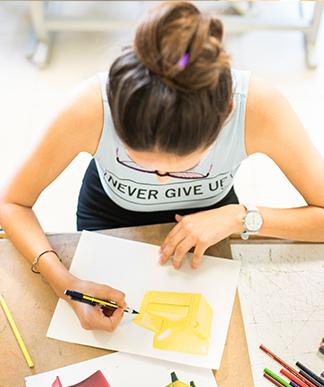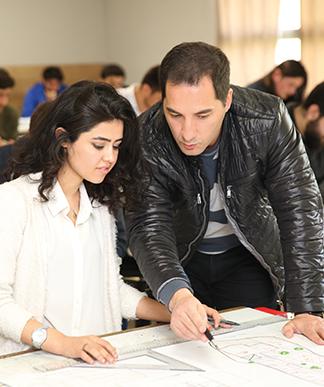


About the Department
The purpose of the Interior Architecture Program is to encourage students to take part in the interior design process within real-life context; to raise the quality of life of the individuals; to increase the efficiency of the social circle; to create spaces that protect the health, safety and well-being of the public; and to integrate theory and practice through individual and administrative problem-solving strategies. The program aims to provide a balance between art, technology and human aspects of the profession, with an awareness of the modern trends and the most recent technological developments in the field of interior architecture. The vision of the program is to ensure that the students gain expert knowledge and experience during their undergraduate education; recognize the importance of geography and universal values; develop a versatile designer identity; demonstrate competence in both current and future artistic and design issues; and focus on responsibility, awareness and social / professional ethics.
Education Opportunities
Aiming to integrate theory and practice through individual and collaborative problem solving strategies, in a process that encourages the individual to improve the quality of life, increase the efficiency of the social environment, and create spaces that will protect the health, safety and welfare of the public, the Interior Architecture undergraduate program offers students the appropriate instructional learning environment and opportunities.
Basically, the program focuses on the interior design studio and encompasses courses in other subject areas such as history, theory, technology, construction materials, experimental design, environment, and visual communication. The design process places extensive emphasis on design fundamentals, observation, research, spatial development, and the social aspects of space. Also, various electives are included in six semesters to ensure students receive a well-rounded academic base that will enhance both their personal and professional development.
With qualified academic staff, in-curricular and extra-curricular academic activities are carried out in studios, classrooms, laboratories, workshops, and technical trips, and students are offered opportunities to develop competencies related to the interior architecture profession.
In this way, the students gain the ability to use their project-based problem-solving skills to create functional and aesthetic interior designs that will benefit society. When designing their future living environments, they can take into account the traditions, values, and cultural and architectural heritage of different communities, which can create design solutions that can respond to the needs of various cultures and contexts, while also bringing a cultural perspective to environmental studies. By using contemporary technologies and the materials, textures, and colors required by this technology in the design process, they can develop the ability to express these design ideas creatively with various drawing and presentation techniques. They can work in collaboration with different disciplines such as architecture and landscape design by developing multidimensional perspectives in design and practice. Feeling the social and environmental responsibility, they can apply ethical responsibility, aesthetic expression, and practical applications in the dimension of professional standards. There are opportunities for new uses of historical interiors, respecting the architectural and historical heritage, and gaining the ability to use contemporary practices in this context.
Furthermore, the Interior Architecture program provides students with the opportunity of getting a second undergraduate degree (double major) or gaining knowledge in a specific field (minor program) as a student at a different program in addition to Interior Architecture.

Career Areas
Graduates of the Department of Interior Architecture are able to work with different design areas. They can work with infrastructure architects to design the interior of offices. Graduates can also set up their own offices in the construction, furniture, retail sectors, both in the design, marketing, creativity units; and they can show their imagination on preserving historical structures. The courses on furniture and interior architecture are offered with experimental design components, to showcase work, giving students the opportunity to design scenery and places of visual entertainment. There is also a possibility of an academic career in higher education institutions. An interior architect can have a successful career by accurately making use of their human relations and psychology in all aspects of creativity.
Contact
Faculty of Fine Arts, Design and Architecture
Education and Humanities Center, EH323
Tel: +90 392 671 1111 Extension: 2101
Faculty E-mail: secretary-ffa@ciu.edu.tr
Head of Department: Prof. Dr. Sevinç Kurt
Head of Department E-mail: skurt@ciu.edu.tr
Compulsory Courses
First Semester
READING AND WRITING SKILLS-I
Course code
ENGL141Credit
3Theoretical
2Practical
2Ects
4FREEHAND DRAWING
Course code
FADA103Credit
3Theoretical
2Practical
2Ects
3BASIC DESIGN FOR INTERIOR ARCHITECTURE-I
Course code
INAR101Credit
6Theoretical
4Practical
4Ects
9INTERIOR DESIGN DRAWING-I
Course code
INAR105Credit
3Theoretical
2Practical
2Ects
4ERGONOMICS IN INTERIOR DESIGN
Course code
INAR107Credit
3Theoretical
2Practical
2Ects
3GEOMETRY FOR INTERIOR DESIGNERS
Course code
INAR109Credit
3Theoretical
2Practical
2Ects
3INTRODUCTION TO COMPUTERS
Course code
ITEC110Credit
3Theoretical
2Practical
2Ects
4Second Semester
INTRODUCTION TO CONSTRUCTION
Course code
ARCH108Credit
3Theoretical
2Practical
2Ects
4READING AND WRITING SKILLS-II
Course code
ENGL142Credit
3Theoretical
2Practical
2Ects
4RENDERING AND PRESENTATION TECHNIQUES
Course code
FADA104Credit
3Theoretical
2Practical
2Ects
3BASIC DESIGN FOR INTERIOR ARCHITECTURE-II
Course code
INAR102Credit
6Theoretical
4Practical
4Ects
9INTERIOR DESIGN DRAWING-II
Course code
INAR106Credit
3Theoretical
2Practical
2Ects
4DESCRIPTIVE GEOMETRY & PERSPECTIVE IN INTERIOR ARCHITECTURE
Course code
INAR110Credit
3Theoretical
2Practical
2Ects
4TURKISH LANGUAGE
Course code
TREG100Credit
0Theoretical
2Practical
0Ects
2TURKISH
Course code
TURK100Credit
0Theoretical
2Practical
0Ects
2Third Semester
HISTORY OF ANCIENT ARCHITECTURE
Course code
ARCH211Credit
2Theoretical
2Practical
0Ects
2COMPUTER AIDED DESIGN-I
Course code
FADA205Credit
3Theoretical
2Practical
2Ects
4INTERIOR ARCHITECTURAL DESIGN-I
Course code
INAR201Credit
6Theoretical
4Practical
4Ects
9BUILDING MATERIALS FOR INTERIOR DESIGN
Course code
INAR203Credit
3Theoretical
2Practical
2Ects
4BUILDING CONSTRUCTION IN INTERIOR ARCHITECTURE-I
Course code
INAR207Credit
3Theoretical
2Practical
2Ects
4BUILDING PHYISCS IN INTERIOR ARCHITECTURE-I
Course code
INAR209Credit
3Theoretical
2Practical
2Ects
4AREA ELECTIVE
Course code
INARXX1Credit
2Theoretical
2Practical
0Ects
3Fourth Semester
HISTORY OF EUROPEAN ARCHITECTURE
Course code
ARCH212Credit
2Theoretical
2Practical
0Ects
2COMPUTER AIDED DESIGN-II
Course code
FADA206Credit
3Theoretical
2Practical
2Ects
4INTERIOR ARCHITECTURAL DESIGN-II
Course code
INAR202Credit
6Theoretical
4Practical
4Ects
9EXPERIMENTAL DESIGN FOR INTERIOR DESIGNERS
Course code
INAR204Credit
3Theoretical
2Practical
2Ects
4BUILDING CONSTRUCTION IN INTERIOR ARCHITECTURE-II
Course code
INAR208Credit
3Theoretical
2Practical
2Ects
4BUILDING PHYSICS IN INTERIOR ARCHITECTURE-II
Course code
INAR210Credit
3Theoretical
2Practical
2Ects
4AREA ELECTIVE
Course code
INARXX2Credit
2Theoretical
2Practical
0Ects
3Fifth Semester
RESTORATION AND PRESERVATION-I
Course code
ARCH305Credit
2Theoretical
2Practical
0Ects
2INTRODUCTION TO LANDSCAPE ARCHITECTURE
Course code
ARCH307Credit
3Theoretical
2Practical
2Ects
4HISTORY OF TURKISH & CYPRIOT ARCHITECTURE
Course code
ARCH311Credit
2Theoretical
2Practical
0Ects
2SUMMER TRAINING-I
Course code
INAR200Credit
0Theoretical
0Practical
0Ects
5INTERIOR ARCHITECTURAL DESIGN-III
Course code
INAR301Credit
6Theoretical
4Practical
4Ects
9FURNITURE DESIGN AND CONSTRUCTION-I
Course code
INAR303Credit
3Theoretical
2Practical
2Ects
4INTERIOR DETAILING
Course code
INAR309Credit
3Theoretical
2Practical
2Ects
4Sixth Semester
RESTORATION AND PRESERVATION-II
Course code
ARCH306Credit
3Theoretical
2Practical
2Ects
6HISTORY OF CONTEMPORARY ARCHITECTURE
Course code
ARCH312Credit
2Theoretical
2Practical
0Ects
2INTERIOR ARCHITECTURAL DESIGN-IV
Course code
INAR302Credit
6Theoretical
4Practical
4Ects
9FURNITURE DESIGN AND CONSTRUCTION-II
Course code
INAR304Credit
3Theoretical
2Practical
2Ects
4HISTORY OF INTERIORS AND FURNITURE
Course code
INAR308Credit
3Theoretical
3Practical
0Ects
4PASSIVE SOLAR CONTROL OF INTERIORS
Course code
INAR310Credit
3Theoretical
2Practical
2Ects
5Seventh Semester
INTERIOR DESIGN-V
Course code
INAR401Credit
6Theoretical
4Practical
4Ects
9INTEGRATED APPLICATION OF INTERIOR DESIGN PROJECT
Course code
INAR403Credit
4Theoretical
2Practical
4Ects
6INTERIOR ARCHITECTURE GRADUATION PROJECT RESEARCH
Course code
INAR405Credit
3Theoretical
3Practical
0Ects
4COST ESTIMATION AND SITE MANAGEMENT IN INTERIOR ARCHITECTURE
Course code
INAR407Credit
3Theoretical
3Practical
0Ects
4AREA ELECTIVE
Course code
INARXX3Credit
2Theoretical
2Practical
0Ects
3UNIVERSITY ELECTIVE
Course code
UNIEXX1Credit
3Theoretical
3Practical
0Ects
4Eighth Semester
HISTORY OF CIVILIZATION
Course code
HIST100Credit
0Theoretical
2Practical
0Ects
2SUMMER TRAINING-II
Course code
INAR300Credit
0Theoretical
0Practical
0Ects
5INTERIOR DESIGN GRADUATION PROJECT
Course code
INAR402Credit
6Theoretical
4Practical
4Ects
12DESIGN ETHICS AND LEGAL ISSUES OF INTERIOR ARCHITECTURE
Course code
INAR404Credit
3Theoretical
2Practical
2Ects
2ANALYSIS OF DESIGN CULTURE AND THEORY
Course code
INAR406Credit
2Theoretical
2Practical
0Ects
2AREA ELECTIVE
Course code
INARXX4Credit
2Theoretical
2Practical
0Ects
3MODERN TURKISH HISTORY
Course code
TARH100Credit
0Theoretical
2Practical
0Ects
2UNIVERSITY ELECTIVE
Course code
UNIEXX2Credit
3Theoretical
3Practical
0Ects
4Elective Courses
VISUAL DESIGN WITH COMPUTER AIDED PRESENTATION
Course code
ARCH421Credit
3Theoretical
3Practical
0Ects
3VISUAL DESIGN WITH PHOTOSHOP
Course code
INAR224Credit
2Theoretical
2Practical
0Ects
3COLOUR CULTURE
Course code
GRDE304Credit
3Theoretical
2Practical
2Ects
5BASIC PHOTOGRAPHY
Course code
GRDE207Credit
3Theoretical
2Practical
2Ects
5HISTORY OF ART-I
Course code
FADA209Credit
2Theoretical
2Practical
0Ects
2DESIGN FOR SUSTAINABILITY
Course code
INPD309Credit
3Theoretical
2Practical
2Ects
4TYPOLOGY OF BUILDING AND INTERIOR SPACE ANALYSIS TECHNIQUES
Course code
INAR437Credit
2Theoretical
2Practical
0Ects
3MARINE BREAKWATER TYPES AND CHARACTERISTICS
Course code
ARCH485Credit
3Theoretical
3Practical
0Ects
3WORKSHOP PRACTICE IN MODEL MAKING
Course code
INPD207Credit
3Theoretical
2Practical
2Ects
6STYLES AND FASHION IN DESIGN
Course code
INAR444Credit
2Theoretical
2Practical
0Ects
3ADVANCED PHOTOGRAPHY
Course code
GRDE208Credit
3Theoretical
2Practical
2Ects
5DIGITAL PRACTICE
Course code
GRDE108Credit
3Theoretical
2Practical
2Ects
4CREATIVITY IN DESIGN
Course code
GRAP461Credit
2Theoretical
2Practical
0Ects
MARINE CHARACTERISTICS AND CONSTRUCTION
Course code
ARCH484Credit
3Theoretical
3Practical
0Ects
3SPACE ANALYSIS TECHNIQUES
Course code
ARCH477Credit
2Theoretical
2Practical
0Ects
PHYSICAL PLANNING OF TOURISM ESTABLISHMENTS
Course code
ARCH475Credit
3Theoretical
3Practical
0Ects
PRINTMAKING TECHNIQUES
Course code
GRDE305Credit
3Theoretical
2Practical
2Ects
5EXHIBITION DESIGN
Course code
GRAP465Credit
2Theoretical
2Practical
0Ects
3HISTORY OF ARTS-II
Course code
FADA210Credit
2Theoretical
2Practical
0Ects
2WOOD AND GLASS TECHNOLOGY
Course code
ARCH409Credit
2Theoretical
2Practical
0Ects
ARCHITECTURAL SPACE IN MOVIES
Course code
ARCH241Credit
2Theoretical
2Practical
0Ects
HISTORY OF GRAPHIC DESIGN
Course code
GRDE311Credit
2Theoretical
2Practical
0Ects
2SOCIAL & IDEO. ISSUES OF SPACE
Course code
ARCH414Credit
2Theoretical
2Practical
0Ects
3PORTFOLIO DESIGN
Course code
GRDE404Credit
3Theoretical
2Practical
2Ects
6ADVERTISING DESIGN
Course code
GRDE307Credit
3Theoretical
2Practical
2Ects
4VIDEOART AND MULTIMEDIA
Course code
GRDE306Credit
3Theoretical
2Practical
2Ects
5INTERACTIVE DESIGN
Course code
GRDE303Credit
3Theoretical
2Practical
2Ects
4CONTEMPORARY GRAPHIC DESIGN
Course code
GRDE312Credit
2Theoretical
2Practical
0Ects
2MARKETING AND CONSUMER BEHAVIOUR
Course code
FADA309Credit
3Theoretical
3Practical
0Ects
3CLAY AND PLASTER IN DESIGN
Course code
INPD456Credit
2Theoretical
2Practical
0Ects
SKETCHING IN DESIGN
Course code
GRDE110Credit
3Theoretical
2Practical
2Ects
5MEDITERRANEAN ARCHITECTURE
Course code
ARCH420Credit
2Theoretical
2Practical
0Ects
3BASIC JEWELLERY DESIGN
Course code
INPD444Credit
2Theoretical
2Practical
0Ects
ADVANCED PHOTOGRAPHY
Course code
GRTA208Credit
3Theoretical
2Practical
2Ects
5VIRTUAL REALITY IN ARCHITECTURE
Course code
ARCH470Credit
2Theoretical
2Practical
0Ects
3TR Applicants
TR Students who are successful in the exams conducted by the Higher Education Council Student Selection and Placement Center (ÖSYM) and are entitled to enroll in our university in line with their preferences can complete the registration process with the necessary documents for registration from our Registration and Liaison Offices throughout Turkey or from the Marketing Directorate on campus.
Click for detailed admission requirements information.
TRNC Applicants
TRNC citizens and TR citizen candidate students who have completed their entire high school education in TRNC. They are placed in undergraduate programs in line with their success in the CIU Student Placement and Scholarship Ranking Exam and the programs they prefer.
Students who are successful in the exam can register from the TRNC Marketing Office.
Applicants can directly apply online to our undergraduate programs using the application portal. Please fill in your details correctly and upload all the required documents listed on the last page of the application form.
Required documents;
- Completed application form,
- Higher/Secondary Certificate or equivalents (e.g. O/A’Level, WAEC/NECO),
- Evidence of English Language competence: TOEFL (65 IBT) or IELTS (5.5). Students without these documents will take the CIU English proficiency exam on campus following arrival,
- Scanned copy of international passport/birth certificate,
- Fully completed and signed CIU Rules and Regulations document (which can be downloaded during the online application).
Cyprus International University provides academic scholarships for its students as an incentive for success, with most students benefiting from 50%, 75% or 100% scholarships or discounted tuition fees. Click for more information.
Tuition Fees are determined at the beginning of each academic year. Candidate students who are entitled to enroll in CIU can learn their fees in line with the Tuition Fee Calculation system.